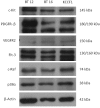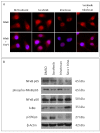Multi-tyrosine kinase inhibitors in preclinical studies for pediatric CNS AT/RT: Evidence for synergy with Topoisomerase-I inhibition
- PMID: 22206574
- PMCID: PMC3278350
- DOI: 10.1186/1475-2867-11-44
Multi-tyrosine kinase inhibitors in preclinical studies for pediatric CNS AT/RT: Evidence for synergy with Topoisomerase-I inhibition
Abstract
Background: Currently, Atypical Teratoid Rhabdoid Tumor (AT/RT) constitutes one of the most difficult to treat malignancies in pediatrics. Hence, new knowledge of potential targets for therapeutics and the development of novel treatment approaches are urgently needed. We have evaluated the presence of cytokine pathways and the effects of two clinically available multi-tyrosine kinase inhibitors for cytotoxicity, target modulation and drug combinability against AT/RT cell lines.
Results: AT/RT cell lines expressed measurable quantities of VEGF, FGF, PDGF and SDF-1, although the absolute amounts varied between the cell lines. The targeted receptor tyrosine kinase inhibitor sorafenib inhibited the key signaling molecule Erk, which was activated following the addition of own conditioned media, suggesting the existence of autocrine/paracrine growth stimulatory pathways. The multi-tyrosine kinase inhibitors sorafenib and sunitinib also showed significant growth inhibition of AT/RT cells and their activity was enhanced by combination with the topoisomerase inhibitor, irinotecan. The loss of cytoplasmic NF-kappa-B in response to irinotecan was diminished by sorafenib, providing evidence for a possible benefit for this drug combination.
Conclusions: In addition to previously described involvement of insulin like growth factor (IGF) family of cytokines, a multitude of other growth factors may contribute to the growth and survival of AT/RT cells. However, consistent with the heterogeneous nature of this tumor, quantitative and qualitative differences may exist among different tumor samples. Multi-tyrosine kinase inhibitors appear to have effective antitumor activity against all cell lines studied. In addition, the target modulation studies and drug combinability data provide the groundwork for additional studies and support the evaluation of these agents in future treatment protocols.
Figures





Similar articles
-
Profiling pathway-specific novel therapeutics in preclinical assessment for central nervous system atypical teratoid rhabdoid tumors (CNS ATRT): favorable activity of targeting EGFR- ErbB2 signaling with lapatinib.Mol Oncol. 2013 Jun;7(3):497-512. doi: 10.1016/j.molonc.2013.01.001. Epub 2013 Jan 11. Mol Oncol. 2013. PMID: 23375777 Free PMC article.
-
Establishment of atypical-teratoid/rhabdoid tumor (AT/RT) cell cultures from disseminated CSF cells: a model to elucidate biology and potential targeted therapeutics.J Neurooncol. 2008 Nov;90(2):171-80. doi: 10.1007/s11060-008-9653-y. Epub 2008 Jul 24. J Neurooncol. 2008. PMID: 18651103
-
Determination of drug synergism between the tyrosine kinase inhibitors NSC 680410 (adaphostin) and/or STI571 (imatinib mesylate, Gleevec) with cytotoxic drugs against human leukemia cell lines.Cancer Chemother Pharmacol. 2003 Oct;52(4):307-18. doi: 10.1007/s00280-003-0668-y. Epub 2003 Jun 25. Cancer Chemother Pharmacol. 2003. PMID: 12827297
-
Opportunities and obstacles to combination targeted therapy in renal cell cancer.Clin Cancer Res. 2007 Jan 15;13(2 Pt 2):764s-769s. doi: 10.1158/1078-0432.CCR-06-1975. Clin Cancer Res. 2007. PMID: 17255307 Review.
-
Role of sunitinib and sorafenib in the treatment of metastatic renal cell carcinoma.Am J Health Syst Pharm. 2008 Jan 15;65(2):123-31. doi: 10.2146/ajhp060661. Am J Health Syst Pharm. 2008. PMID: 18192256 Review.
Cited by
-
Profiling pathway-specific novel therapeutics in preclinical assessment for central nervous system atypical teratoid rhabdoid tumors (CNS ATRT): favorable activity of targeting EGFR- ErbB2 signaling with lapatinib.Mol Oncol. 2013 Jun;7(3):497-512. doi: 10.1016/j.molonc.2013.01.001. Epub 2013 Jan 11. Mol Oncol. 2013. PMID: 23375777 Free PMC article.
-
Atypical Teratoid Rhabdoid Tumour : From Tumours to Therapies.J Korean Neurosurg Soc. 2018 May;61(3):302-311. doi: 10.3340/jkns.2018.0061. Epub 2018 May 1. J Korean Neurosurg Soc. 2018. PMID: 29742888 Free PMC article. Review.
-
Atypical teratoid rhabdoid tumor: current therapy and future directions.Front Oncol. 2012 Sep 12;2:114. doi: 10.3389/fonc.2012.00114. eCollection 2012. Front Oncol. 2012. PMID: 22988546 Free PMC article.
-
Advancing biology-based therapeutic approaches for atypical teratoid rhabdoid tumors.Neuro Oncol. 2020 Jul 7;22(7):944-954. doi: 10.1093/neuonc/noaa046. Neuro Oncol. 2020. PMID: 32129445 Free PMC article.
-
Atypical teratoid/rhabdoid tumors: challenges and search for solutions.Cancer Manag Res. 2016 Sep 16;8:115-125. doi: 10.2147/CMAR.S83472. eCollection 2016. Cancer Manag Res. 2016. PMID: 27695363 Free PMC article. Review.
References
-
- Dufour C, Beaugrand A, Le Deley MC, Bourdeaut F, André N, Leblond P, Bertozzi AI, Frappaz D, Rialland X, Fouyssac F, Edan C, Grill J, Quidot M, Varlet P. Clinicopathologic prognostic factors in childhood atypical teratoid and rhabdoid tumor of the central nervous system: A multicenter study. Cancer. 2011. Electronically published ahead of print. - PubMed
-
- Bouvier C, De Paula AM, Fernandez C, Quilichini B, Scavarda D, Gentet JC, Figarella-Branger D. Atypical teratoid/rhabdoid tumor: 7-year event-free survival with gross total resection and radiotherapy in a 7-year-old boy. Childs Nerv Syst. 2008;24:143–147. - PubMed
LinkOut - more resources
Full Text Sources
Other Literature Sources
Research Materials
Miscellaneous

